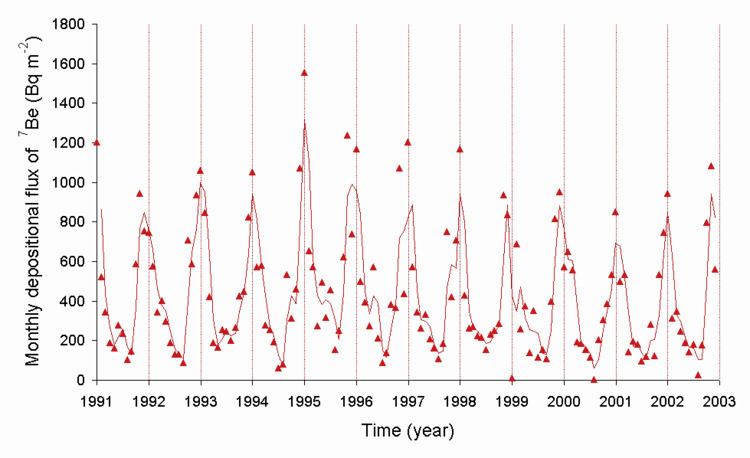 | ||
Beryllium (Be) has 12 known isotopes, but only one of these isotopes (9
Be
) is stable and a primordial nuclide. As such, beryllium is considered a monoisotopic element. It is also a mononuclidic element, because its other isotopes have such short half-lives that none are primordial and their abundance is very low (relative atomic mass 9.012.) Beryllium is unique as being the only monoisotopic element with both an even number of protons and an odd number of neutrons. There are 25 other monoisotopic elements but all have odd atomic numbers, and even numbers of neutrons.
Contents
Of the 11 radioisotopes of beryllium, the most stable are 10
Be
with a half-life of 1.39 million years and 7
Be
with a half-life of 53.22 days. All other radioisotopes have half-lives under 13.85 seconds, most under 0.03 seconds. The least stable isotope is 6
Be
, with a half-life measured as 5.03 × 10−21 seconds.
The natural light-element ratio of equal protons and neutron numbers is prevented in beryllium by the extreme instability of 8
Be
toward alpha decay, which is favored due to the extremely tight binding of 4
He
nuclei. The half-life for the decay of 8
Be
is only 6.7(17)×10−17 seconds.
Beryllium is prevented from having a stable isotope with 4 protons and 6 neutrons by the very large mismatch in proton/neutron ratio for such a light element. Nevertheless, this isotope, 10
Be
, has a half-life of 1.39 million years, which indicates unusual stability for a light isotope with such a large neutron/proton imbalance. Still other possible beryllium isotopes have even more severe mismatches in neutron and proton number, and thus are even less stable.
Most 9
Be
in the universe is thought to be formed by cosmic ray nucleosynthesis from cosmic ray spallation in the period between the Big Bang and the formation of the solar system. The isotopes 7
Be
, with a half-life of 53.22 days, and 10
Be
are both cosmogenic nuclides because they are made on a recent timescale in the solar system by spallation, like 14
C
. These two radioisotopes of beryllium in the atmosphere track the sun spot cycle and solar activity, since this affects the magnetic field that shields the Earth from cosmic rays. The rate at which the short-lived 7
Be
is transferred from the air to the ground is controlled in part by the weather. 7
Be
decay in the sun is one of the sources of solar neutrinos, and the first type ever detected using the Homestake experiment. Presence of 7
Be
in sediments is often used to establish that they are fresh, i.e. less than about 3–4 months in age, or about two half-lives of 7
Be
.
Notes
Decay Chains
Most isotopes of beryllium within the proton/neutron drip lines decay via beta decay and/or a combination of beta decay and alpha decay or neutron emission. However, 7Be decays only via electron capture, a phenomenon to which its unusually long half-life may be attributed. Also anomalous is 8Be, which decays via alpha decay to 4He. This alpha decay is often considered fission, which would be able to account for its extremely short half-life.
